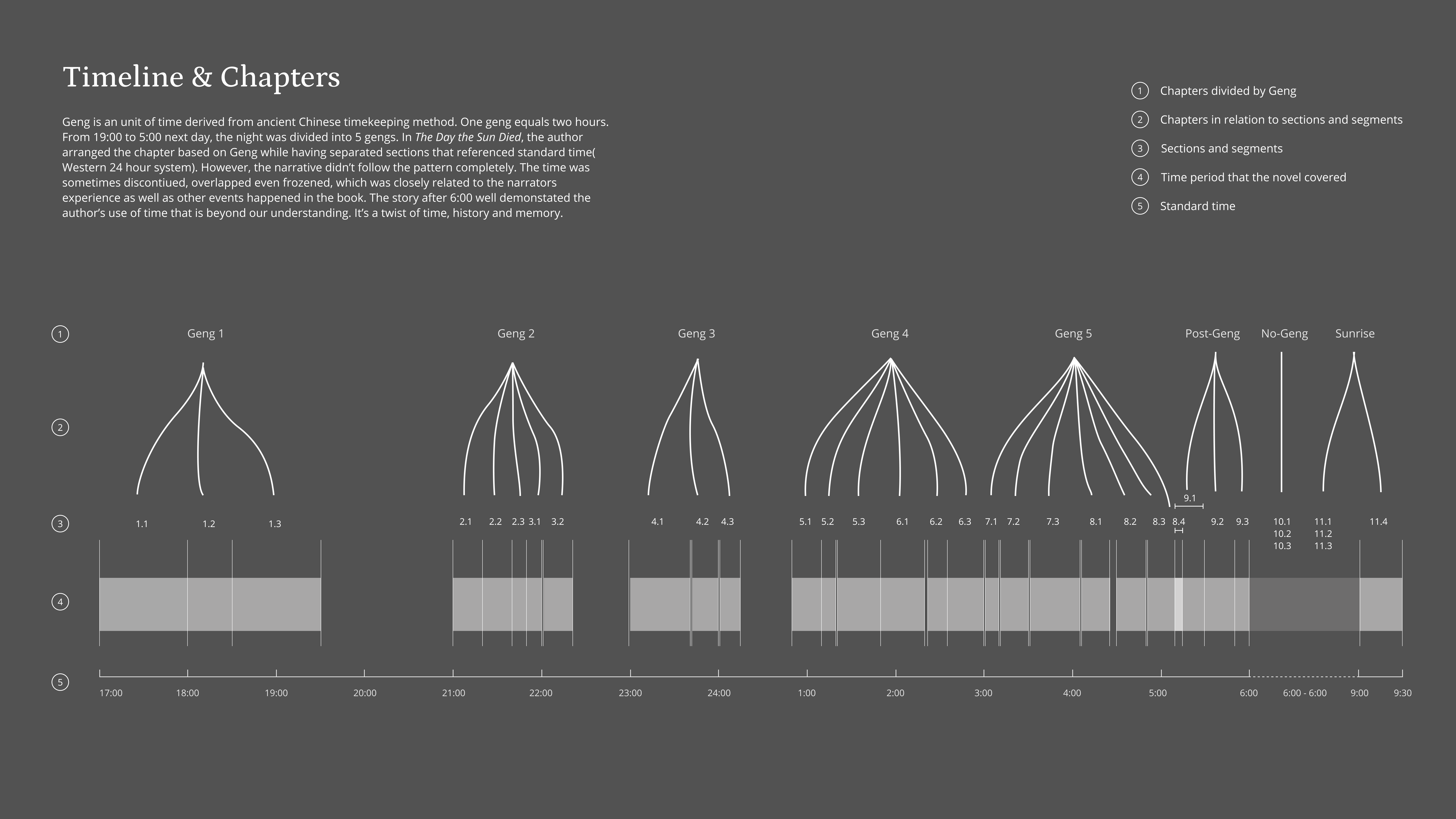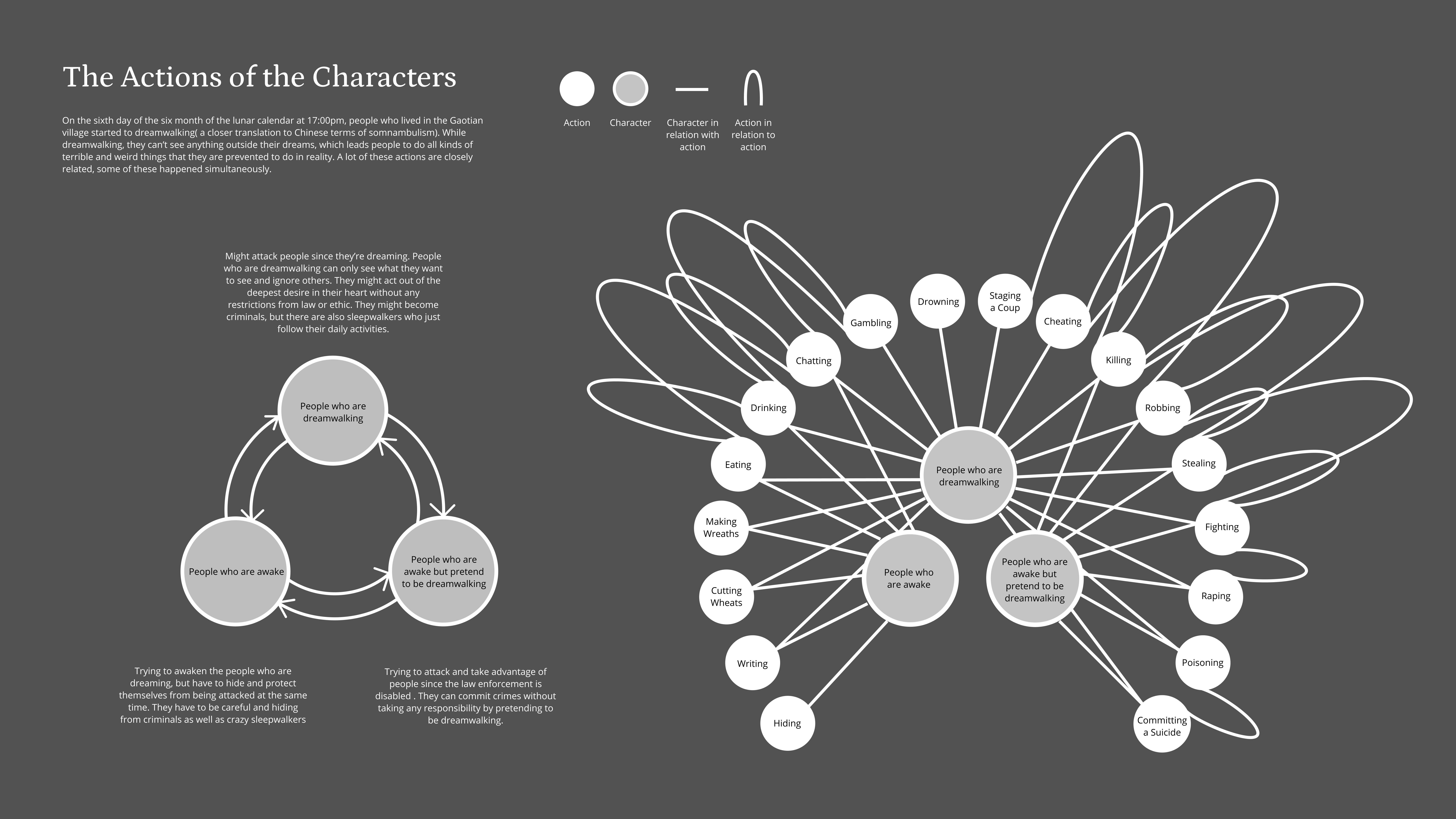The Day the Sun Died
The Day the Sun Died is a novel written by Yan Lianke. This project focus on designing a visual translation of this novel and creating speculative visual design/translation/interpretation/map of the text. I designed 4 different infographics to visualize the timeline, action, system, and the death decribed in the novel.
About the Author
Yan Lianke (Chinese: 阎连科'; born August 1958) is a Chinese writer of novels and short stories, based in Beijing. His work is highly satirical, which has resulted in some of his most renowned works being banned in China.
Most of his novel is about his village. He was inspired a lot by the village where he grew up. He thinks that his village is mysterious. It is extremely wealthy while extremely poor. It is virtuous and malicious. It is a place full of literacy that beyonds anyone’s imagination. People there don’t need any books or novels, because their lives, their behaviors are part of the literature.
Historical Background of the Novel
Started from 1985, the Chinese government had published regulations regarding the burial. The regulations call for cremation while prohibiting ground burial, which people believed to be the only way to bring peace to the deceased. A lot of people resisted to change, especially in rural area.
Protagonists
The protagonist --- Li Niannian, a 14 years old boy who has intellectual disability, is also the narrator of the story. His family is closely related to this policy change. His parents is running a funerary shop that sells burial shrouds and funeral wreaths. His uncle is the owner of a crematorium in the village.
Main Narrative
People lived in the Gaotian village started to dreamwalking. While dreamwalking, they can’t see anything outside their dreams, which leads people to do all kinds of terrible and weird things that they are prevented to do in reality, such as robbery, murder, rape and coup. Li Niannian didn’t dream at all and his narrative kept track each hour passing.
Back to the day when the regulations were published, Niannian’s father Li Tianbao had made money by reporting on families who want to bury deceased in ground secretly. Li Tianbao was a whistle-blower that villagers hated and desperately wanted. His father suffered since then and kept the secret to himself while atoning for his crime by hiding oil generated from cremation instead of allowing it to be sent to factories. ( Because the equipment during that time wasn’t good enough to produce highest temperature that can evaporate oil, the oil was left and could be sale for industrial use.)
Eventually, Li Tianbao burned all the oil with himself to bring the light to save the village.
Infographics
Link to Presentation
![]()
![]()
![]()
![]()
The Day the Sun Died is a novel written by Yan Lianke. This project focus on designing a visual translation of this novel and creating speculative visual design/translation/interpretation/map of the text. I designed 4 different infographics to visualize the timeline, action, system, and the death decribed in the novel.
About the Author
Yan Lianke (Chinese: 阎连科'; born August 1958) is a Chinese writer of novels and short stories, based in Beijing. His work is highly satirical, which has resulted in some of his most renowned works being banned in China.
Most of his novel is about his village. He was inspired a lot by the village where he grew up. He thinks that his village is mysterious. It is extremely wealthy while extremely poor. It is virtuous and malicious. It is a place full of literacy that beyonds anyone’s imagination. People there don’t need any books or novels, because their lives, their behaviors are part of the literature.
Historical Background of the Novel
Started from 1985, the Chinese government had published regulations regarding the burial. The regulations call for cremation while prohibiting ground burial, which people believed to be the only way to bring peace to the deceased. A lot of people resisted to change, especially in rural area.
Protagonists
The protagonist --- Li Niannian, a 14 years old boy who has intellectual disability, is also the narrator of the story. His family is closely related to this policy change. His parents is running a funerary shop that sells burial shrouds and funeral wreaths. His uncle is the owner of a crematorium in the village.
Main Narrative
People lived in the Gaotian village started to dreamwalking. While dreamwalking, they can’t see anything outside their dreams, which leads people to do all kinds of terrible and weird things that they are prevented to do in reality, such as robbery, murder, rape and coup. Li Niannian didn’t dream at all and his narrative kept track each hour passing.
Back to the day when the regulations were published, Niannian’s father Li Tianbao had made money by reporting on families who want to bury deceased in ground secretly. Li Tianbao was a whistle-blower that villagers hated and desperately wanted. His father suffered since then and kept the secret to himself while atoning for his crime by hiding oil generated from cremation instead of allowing it to be sent to factories. ( Because the equipment during that time wasn’t good enough to produce highest temperature that can evaporate oil, the oil was left and could be sale for industrial use.)
Eventually, Li Tianbao burned all the oil with himself to bring the light to save the village.
Infographics
Link to Presentation



